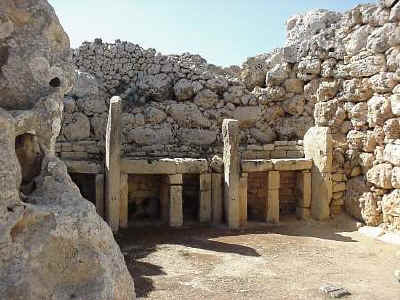 |
 |
 |
The Maltese islands were probably part of a chain of land connecting Europe to Africa. Bones from prehistoric and extinct animals have been dated to as far back as 100,000 BC. Teeth from Neanderthal humans were found in caves near the coast, dating from about 40,000 BC.
|
The cave at Ghar Dalam was formed by a river and wasn't discovered until 1865. Ghar Dalam, which means Cave of Darkness, yielded distinct layers of bones and human artifacts, some of which were dated as far back as the Pleistocene era. Fossils were discovered from dwarf elephants, hippopotami, and bears. A small museum on the grounds has reassembled the skeletons of some extinct animals to see what once lived nearby. |
|
|
This structure is in a set of temples called Ggantija on the northern Maltese island of Gozo. It predates the pyramids of Egypt and Britain's Stonehenge by about a thousand years. Ggantija is the earliest free-standing stone structure in the world and covers about a quarter of an acre. The rear wall is about 20 feet high and contains stones that weigh forty to fifty tons. |
 |
|
|
|
Hagar Qim (which means Standing Stones) is another large megalithic monument on Malta's main island. Originally, these temples had wooden roofs which have since deteriorated away. Sacrifices were made at altars to shrines that probably represented Mother Earth. Many objects and sculptures, originally found at the site, are now on display at the Archaeological Museum in Valletta. For example, the museum displays dozens of slabs decorated with the spiral design you see in the photo above. |
|
|
This statue, at Tarxien, is probably the first-known freestanding statue of a deity. The original statuette was probably about eight feet high. There were many stone statuettes, mostly without heads, found at the prehistoric sites and now kept in museums. They are especially distinctive because their heads (when heads are included), hands and feet are of normal size, but their bodies and legs are enormous. In some cases, the headless statues have an indentation at the top of the body. Heads with protrusions that fit right into the bodies have been found nearby. |